Counter-conditioning and desensitization are popular techniques to adjust a cat’s behaviors or feelings in certain scenarios. These methods are often applied to assist cats in dealing with fears, worries, or other behavioral challenges.
Counter-conditioning is all about swapping a cat’s fearful reaction with a neutral or pleasant one. This method pairs the intimidating factor with something the cat loves. Over time, the cat will relate the once-frightening thing with a positive experience, which helps lessen her fear.
For instance, if a cat dreads being inside her cat carrier for vet trips, you can give her treats or toys when she’s in or near the carrier. Over time, the cat will link the carrier with good things, lessening her apprehension.
Desensitization means slowly introducing the cat to what scares her in a controlled setting. The exposure starts off mild, not triggering a strong reaction and then gets more intense over time. This process helps the cat acclimatize to the stimulus without feeling overwhelmed.
For example, if your cat is wary of loud sounds, start by playing the noise softly and turn up the volume as she gets more at ease.
Both these techniques are vital for cat training. They tackle many issues and fears cats face, like aggression, litter box troubles, and separation worries.
Dive into this detailed guide to understand and apply counter-conditioning and desensitization, so your cat can face her fears and behave better!
How Do Fear And Anxiety Impact Cats?
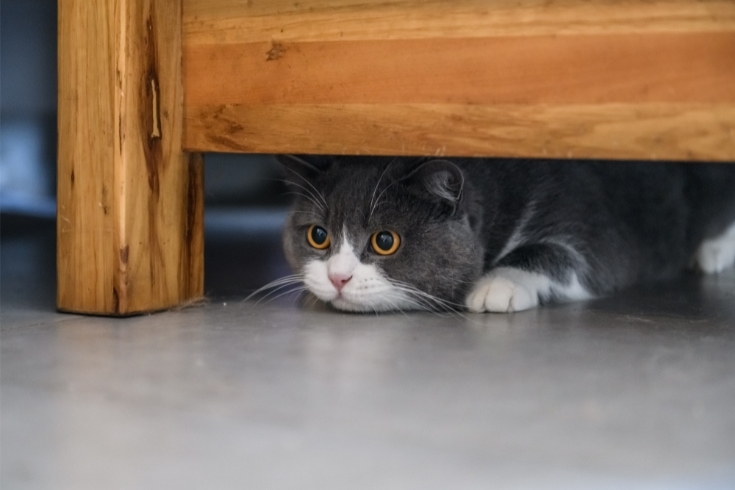
Fear and anxiety can significantly impact your cat, ruining her quality of life and causing health problems. So learning how to identify fear responses and understanding what causes your cat to become anxious is crucial.
Behavioral Changes
Fear and anxiety cause behavioral changes in cats, including over-grooming, hiding, aggression, decreased appetite, and avoidance of people and other animals. Some cats might become more vocal, whereas others display the opposite behavior and become unusually quiet and withdrawn.
Physical Symptoms
A stressed cat might display physical symptoms, such as vomiting, diarrhea, excessive shedding, changes in litter box habits, and even over-grooming to the point of causing skin issues.
Health Problems
Long-term stress and anxiety can weaken a cat’s immune system, leaving the animal more susceptible to illnesses, and chronic stress can even contribute to long-term health problems.
Decreased Quality Of Life
If the cat constantly feels stressed, afraid, or anxious, her quality of life will decline. That can mean withdrawing from interaction with your family and other pets, being reluctant to take part in training and exercise, no longer wanting to play, and generally being unable to enjoy their environment.
Identifying Fear Responses In Cats
Your cat will display several signs when she’s afraid, and you must know how to recognize these so that you can help your pet.
Hiding: A fearful cat often hides away when she feels threatened or anxious, squeezing under furniture, sneaking into your closet, or hiding behind the sofa.
Ears and tail: If your cat flattens her ears or tucks her tail in, that can indicate anxiety and fear, and an upright tail with a slightly puffed-out end typically signifies agitation or heightened awareness.
Dilated pupils: Dilated or enlarged pupils are a common sign of fear or stress in cats.
Hissing and growling: Hissing and growling are common defensive behaviors that show your cat feels threatened. I have a puppy who just wants to play with my two cats. Unfortunately, the cats are not keen on that idea and hiss at poor Raffles, who can’t understand why his housemates are so reluctant to play fetch or tug-of-war with him!
Avoidance: When your cat is afraid, she might go out of her way to avoid people, other pets, or certain parts of your home where she feels threatened.
Common Causes Of Anxiety In Cats
Common causes of anxiety in cats include many things your pet will encounter daily in and around your home.
Environmental Changes
Cats are very much creatures of habit, so any changes in their environment, such as rearranging your furniture or bringing a new pet into the family, can cause anxiety.
Loud Noises
Thunderstorms, fireworks, or loud construction sounds can all trigger a fear response in your cat.
Social Stressors
Cats are territorial creatures, so bringing a new pet, baby, or lodger into your household can lead to anxiety for your cat.
Lack of Routine
Cats are happiest when given a regular routine, so changes in feeding schedules, play times, and even litterbox maintenance can all cause stress.
Medical Conditions

Some health conditions can make your pet anxious because of the discomfort or pain they cause. If you notice your cat’s behavior changing, that could be due to an underlying health problem you’re unaware of, so consult your vet and have your pet checked over to be safe.
Isolation and Boredom
Cats are social, intelligent animals; isolation or a lack of mental and physical stimulation can lead to anxiety.
Traumatic Experiences
Past negative experiences, such as accidents or abuse in a former household, can leave lasting psychological effects on a cat, predisposing her to anxiety in certain circumstances.
What Is Counter-Conditioning?
Counter-conditioning is a behavioral training technique that’s used to change a cat’s emotional reaction to a specific experience. This technique involves exposing the cat to an experience that makes her afraid and teaching her to associate that scary experience with something positive.
For example, if your cat is afraid of visiting the vet clinic, use positive reinforcement training by taking your pet to the vet on a “dry run,” then have the staff feed her treats and pet her when you get there. That way, your kitty learns that going to the vet doesn’t always mean needles and other scary stuff; it can mean fuss and tasty treats instead!
How Can Counter-Conditioning Be Used To Modify Cat Behavior?
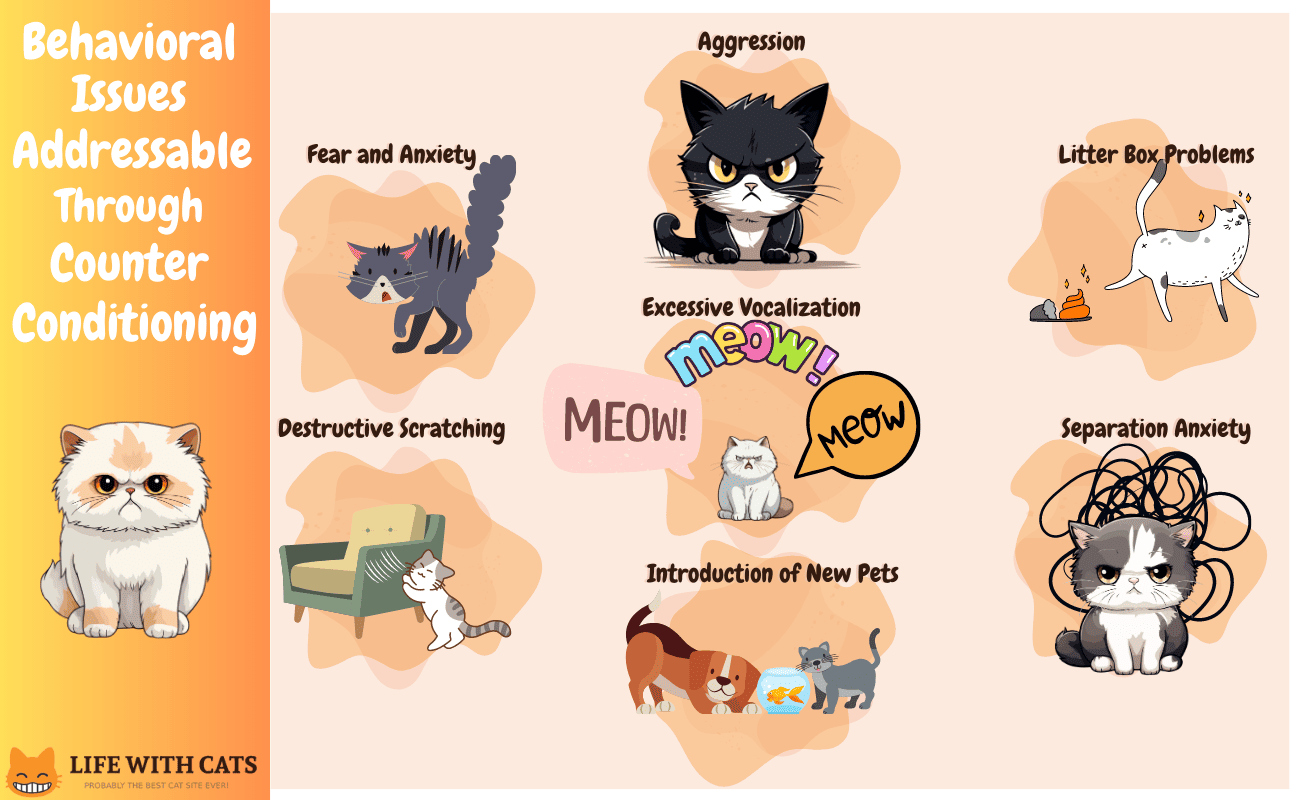
You can use counter-conditioning to modify your cat’s behavior by helping her develop more positive associations with certain experiences or triggers to which she might react negatively.
By pairing that feared or disliked experience with something more pleasant, your cat gradually learns to feel more relaxed and less anxious when she’s in that situation.
Which Behavioral Issues Can Be Addressed With Counter-Conditioning?
Counter-conditioning can be extremely effective in addressing various behavioral issues in your cat, including the following:
Fear And Anxiety
Counter-conditioning can be used to work on fear and anxiety by exposing your cat to whatever she is afraid of at a very low intensity and pairing that with highly rewarding and pleasurable experiences, such as treats or playtime.
Gradually, usually over a few weeks or months, your cat learns to associate the previously fear-inducing experience with positive feelings, reducing her fear and anxiety.
Aggression
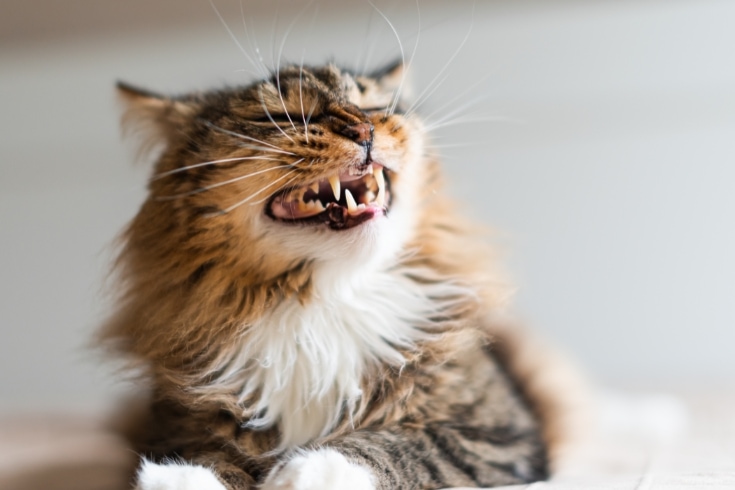
For cats with aggression issues, counter-conditioning involves exposing your cat to whatever triggers her aggressive behavior at a safe distance and rewarding your pet when she is calm. Eventually, your pet learns that the presence of the trigger doesn’t lead to a negative outcome but instead earns her positive rewards.
Litter Box Problems
To fix litter box problems, counter-conditioning typically involves creating a positive association for your cat with the litter box area. For example, offering your cat treats or playing with her near the box will help your pet to develop a positive connection with that space, reducing aversion or avoidance.
Destructive Scratching
Counter-conditioning for destructive scratching behavior means providing a scratching post or scratching mat and rewarding your cat for using it. That helps the cat associate scratching and claw sharpening with a positive experience, encouraging her to use the designated scratching surface in the future rather than your furniture.
Excessive Vocalization
When dealing with excessive vocalization, counter-conditioning focuses on rewarding the cat when she is quiet and providing her with attention when she is calm. That helps teach the cat that she will receive the attention and rewards she craves without yowling and meowing!
Separation Anxiety
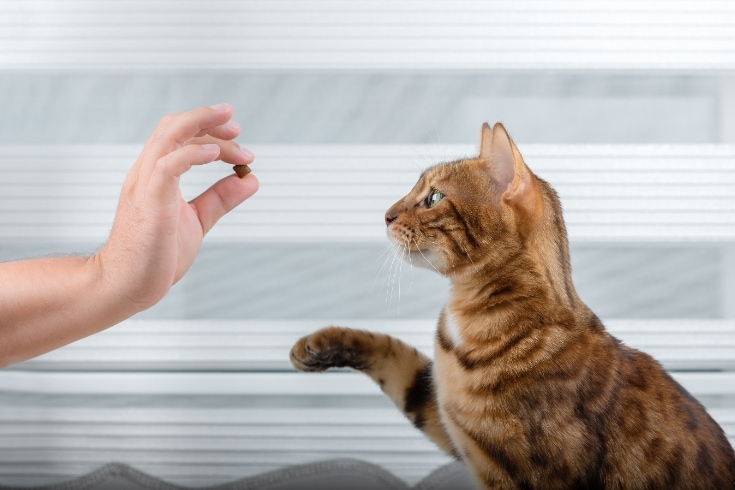
You can use counter-conditioning to alleviate separation anxiety by gradually desensitizing the cat to your departure signals. The cat is exposed to those cues in a non-threatening way and is rewarded for staying calm, helping her to associate you going out with something positive, such as a fun puzzle toy or treat snuffle mat.
Introduction Of New Pets
When bringing a new pet home, counter-conditioning involves introducing the new pet to your cat by pairing the experience with playtime or treats. That helps the resident cat associate the new pet with a rewarding, positive experience, which can reduce potential aggressive or territorial behavior.
In all these cases, patience and consistency are critical, and counter-conditioning must be implemented gradually and adjusted depending on your cat’s progress and comfort level. If your cat has significant behavioral issues, I advise you to ask a vet or professional animal behaviorist for their advice rather than struggling alone.
What Are Some Effective Techniques For Counter-Conditioning Cats?
So, you can see that counter-conditioning can be incredibly helpful for addressing various behavioral issues in your cat, such as fear, anxiety, and aggression.
Here are some highly effective techniques for counter-conditioning cats:
Positive Reinforcement
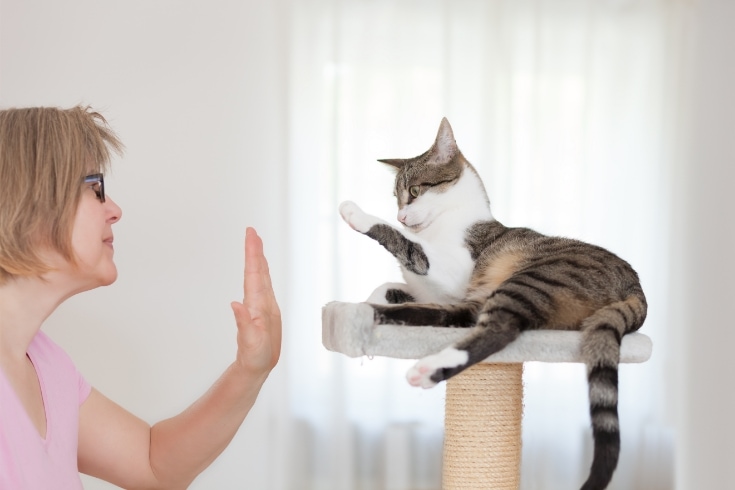
Positive reinforcement training means rewarding your cat immediately for desired behavior. Rewards can take the form of treats, verbal praise, a game with your favorite toy, or simply making a fuss about your pet.
Create Positive Associations
Create positive associations for your cat by pairing the stimulus that frightens her or makes her anxious with something your pet loves. For example, if your cat is afraid of a particular sound, play that sound at a very low volume while playing with your cat or offering her treats. As your pet becomes more comfortable with the sound, gradually turn up the volume.
Use High-Value Rewards
High-value rewards are treats or toys that your cat absolutely loves and would do anything to get! Using high-value rewards can help create a stronger positive association with the stimulus your train to counter-condition your cat to.
Calming Pheromones
As part of your counter-conditioning training, you might find using calming pheromone products, such as Feliway sprays or plugins, helps to keep your cat relaxed and less anxious in a situation that usually triggers fear.
Distraction
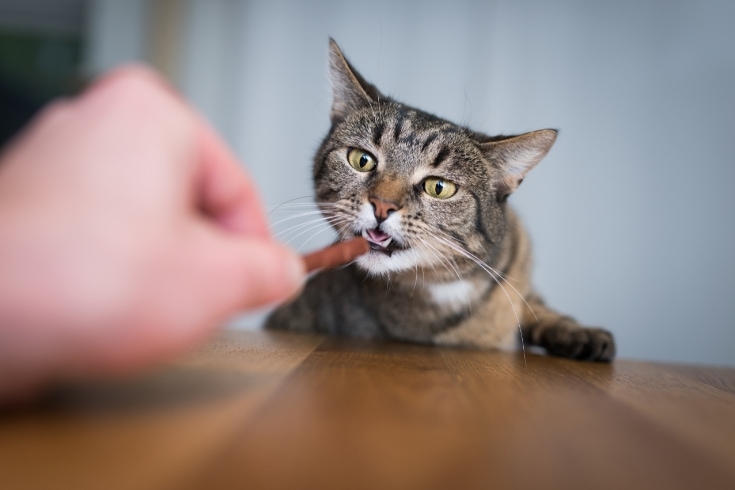
If your cat is reactive or fearful in a particular situation, try distracting her by using food to create a positive association instead. For example, offering your cat some treats or a meal when noisy construction is going on outside your home can distract your cat with something positive.
What Is Desensitization?
In simple terms, desensitization is a training technique by which you gradually expose your feline friend to something she is scared of, but in a controlled and gentle way. Once your cat relaxes, you increase her exposure to the fear stimulus until you eradicate or significantly reduce your kitty-cat’s fearful response.
How Can Desensitization Be Used To Modify Cat Behavior?
Desensitization works rather like easing yourself into a cold swimming pool; you get used to it bit by bit! By slowly introducing your cat to her fears and pairing that with positive experiences, your furry friend learns there’s no need to be afraid over time.
Which Behavioral Issues Can Be Addressed With Desensitization?
So, what can behavioral issues can desensitization be used to address? So, this training strategy can come to your rescue with a whole bunch of cat behavioral problems, including the following:
Fear And Phobias
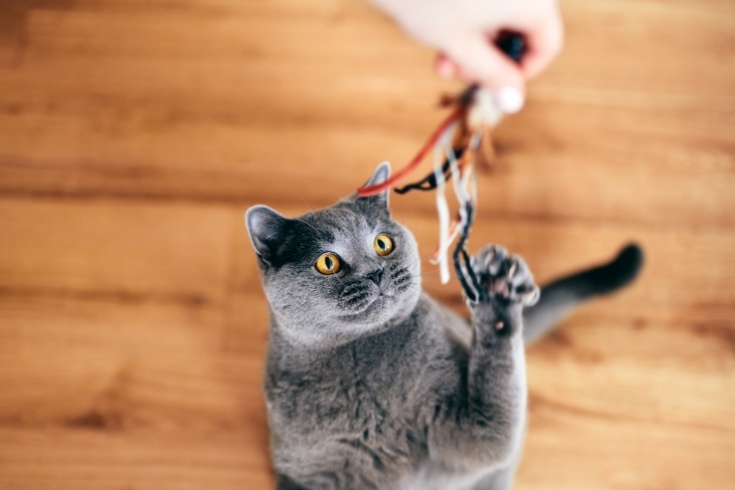
You can help your kitty feel more comfortable, less anxious, and less afraid over time by using counter-conditioning, which pairs the scary thing with something pleasant like a tasty treat or playtime.
Handling Sensitivity
If your cat hates being touched in certain spots, counter-conditioning means petting her while giving her treats, effectively making touch a good, rewarding experience.
Aggression Triggers
Some cats become aggressive when confronted with another cat on their patch; counter-conditioning can help. For example, you could show your cat another feline from a safe distance, rewarding your pet when she remains calm.
Territory Issues
You can use counter-conditioning to deal with aggressive territory issues by introducing your cat to the spot and offering her treats and petting to help her associate the area with positive vibes.
Handling Medical Procedures
Most cats don’t enjoy vet visits, and you can use desensitization techniques to make a trip to the vet less of a horror show. That could mean playing vet at home, touching your pet’s paws or ears, opening her mouth to examine her teeth, and rewarding her with treats and praise when she remains calm.
Separation Anxiety
To desensitize your cat while you’re away from home, leave her for short periods, reward her with treats when you return, and extend your absence over time. Before you know it, your cat will be more at ease when you’re away, and she might not miss you!
What Are Some Practical Steps For Desensitizing Cats?
Desensitization is quite a scary word for many cat owners, but using this technique isn’t as difficult as it sounds.
Here are some practical steps and tips for desensitizing your cat.
Start Slow
As with any new training process, start slowly and take baby steps. Begin with the least scary version of the anxiety or fear trigger and gradually up the ante until your cat is dealing with the scariest of scary things without reacting at all.
Consistency Is Key
When using counter-conditioning or desensitization training, be consistent in your approach and try to set up a regular routine.
Always Pair With Positives
When working to desensitize your cat, always pair a negative experience with a positive one. For example, always have treats, a favorite toy, or a cuddle ready as an immediate reward when your cat stays calm in a scary situation.
Monitor Your Cat’s Behavior
Throughout your cat’s desensitization training, always monitor her behavior and be ready to immediately take a step back if she becomes anxious or distressed. End on a positive note, and accept that your cat might take longer to overcome her fears.
Cat Behavior Modification Frequently Asked Questions
In this part of our guide to counter-conditioning and desensitization, we answer some of the most frequently asked questions on the subject. If you don’t find the information you want, shoot us your question in the comments box below, and we’ll do our best to answer it for you!
How Long Does It Take To See Results From Cat Behavior Modification?
How long it takes to see results from cat behavior modification depends on the specific behavior, the individual cat, and how consistent you have been with your training. Some minor behavioral issues can be improved in a matter of days or weeks, whereas more complex, ingrained behaviors could take months or even longer to modify.
Can Behavior Modification Work For Older Cats?
Yes, it can. Older cats can learn and modify their behavior, although it might take more patience and consistency on your part, depending on how long-standing the unacceptable behavior is.
What Are Some Signs That A Cat May Need Behavior Modification?
Common signs that a cat may need behavior modification can include the following:
- Aggression towards people and other pets
- Excessive vocalization
- Peeing or pooping outside the litter box
- Compulsive behaviors, such as overgrooming
- Disruptive behaviors, including scratching furniture and floor coverings
- Being fearful and hiding the way for no apparent reason
If your cat suddenly changes her behavior for no good reason, we advise you to consult your vet if your furry friend has an underlying health condition that is troubling her.
Can Cat Behavior Modification Be Done Without Professional Help?
Yes, many minor cat behavior issues can be modified by a dedicated and knowledgeable owner, and many resources are available, such as books, online articles, and videos that you can use to guide you. However, if your cat has serious or severe behavioral issues, it’s generally better to ask the advice of a professional, such as a vet or animal behaviorist with a specialism in cats.
Are There Any Risks Or Side Effects Associated With Behavior Modification
The main risks associated with behavior modification come from using negative or inappropriate methods. Negative reinforcement and punishment can make your cat afraid of you, aggressive toward you, or develop other undesirable behaviors. For that reason, we always recommend using positive reinforcement techniques.
In addition, pushing your cat too hard or fast can cause her even more stress or anxiety, which will reduce your behavioral modification training.
How Can I Prevent My Cat From Reverting Back To Its Old Behaviors?
You can do several things to prevent your cat from reverting to her old behaviors.
- Once the desired behavior is achieved, you will need to continue reinforcing it through consistent, ongoing training sessions.
- Keep your cat mentally and physically stimulated by providing environmental enrichment in the form of interactive games, regular training, and exercise sessions.
- Be alert to any environmental changes that might trigger old behaviors and take steps to address them right away.
- Use positive reinforcement training techniques to reward and praise your cat when she displays desired behaviors.
Are There Any Specific Toys Or Products That Can Aid In Cat Behavior Modification
There are quite a few specific toys and other products that can aid in cat behavior modification, including:
- Puzzle toys can engage the cat’s mind and redirect unwanted behaviors.
- Scratching posts or mats are handy if your cat scratches your furniture or floor coverings.
- Calming sprays or diffusers can help reduce stress or aggression in some cats.
- Clickers are handy devices used for clicker training, a form of positive reinforcement.
- Litter attractants can be useful for cats that don’t want to use the litter box.
- Interactive toys are great for engaging your cat’s natural hunting instincts and can be effective in redirecting aggression.
Remember that every cat is an individual, and what works for one might not be effective for another.
Conclusion
Counter-conditioning and desensitization behavioral training techniques that you can use to modify your cat’s unwanted behavior or emotional reactions to certain situations.
Counter-conditioning replaces a cat’s negative or fearful emotional response with a positive one. The technique typically involves pairing the frightening thing with something the cat finds enjoyable so that she learns to associate her previous fear with something nice, gradually reducing her anxiety.
Desensitization is another training technique where the cat is exposed to her fears in a controlled way. You start by using a very low-intensity exposure to the scary thing so that you don’t trigger a violent reaction, gradually increasing the exposure over time.
Counter-conditioning and desensitization are highly-effective training techniques for cats that can help correct and improve many behavioral issues in cats, such as fear, aggression, litter box problems, and separation anxiety.
These techniques are easy to learn, and you can use them to fix minor cat behavioral issues. However, before you start, we advise you to have your pet checked by a vet in case underlying health conditions are to blame for your feline friend’s unruly behavior.